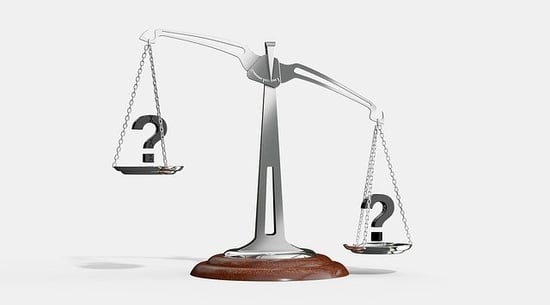
Choosing whether to take the SAT or ACT for college admissions has always been tough. But now that the SAT is switching over to a digital format, there’s even more to consider!
In this article, we’ll give you the info you need to choose the best college entrance exam option for you. We’ll:
- Explain how the transition to the digital SAT, or DSAT, impacts your decision-making
- Provide a complete comparison between the DSAT and the ACT (nifty chart included!)
- List the reasons you might prefer the ACT over the DSAT, or visa versa
- Give you a quick, five question quiz to help you decide whether the DSAT or ACT is right for you
Are you ready? Let’s dive in!
Note: ACT, Inc. is running a small pilot in December to test out a digital version of their test, so some of this is subject to change and will be updated as we know more. The ACT is currently set to be offered in both paper and online versions but otherwise stay the same.
Why Is Choosing Between the Digital SAT vs ACT More Complicated?
Before the SAT went digital, choosing between the SAT and ACT was a totally different ballgame. Both were paper and pencil exams, and while they tested students over different subjects and content, the exam experience was pretty similar.
With the digital SAT, that’s all changing. The DSAT has fewer sections, shorter questions, and it’s taken digitally–like the name implies! Since the SAT and ACT were already different, the shift to a shorter, digital exam will make the differences between the ACT vs digital SAT even more important for test takers.
Now, choosing between the Digital SAT vs ACT will feel even more like picking between two really different exams. That’s why it’s important to know all the differences before you commit.
ACT vs Digital SAT: What Are the Main Differences?
The DSAT and ACT have some pretty significant differences that impact how students take the test and the material they’re tested over. See our side-by-side comparison of the DSAT and ACT below:
|
DSAT |
ACT |
|
|
Administration Format |
Computer-adaptive exam |
Paper booklet, pencil |
|
Length of exam |
2 hours 14 minutes |
2 hours 55 minutes |
|
Total # of questions/tasks |
98 questions |
215 questions, 216 with optional essay |
|
Sections |
|
|
|
Questions per section |
|
|
|
Time per section (in minutes) |
|
|
|
Time per question |
Approximately 65 seconds |
Approximately 45 seconds |
|
Guessing penalty |
None |
None |
|
Score range |
400-1600 |
1-36 |
|
What you can use on the exam |
|
|
Both the DSAT and ACT assess students’ skills and knowledge to gauge how ready they are for college or their future careers. They also include some similar skills testing, like a Reading section that asks students to answer multiple choice questions based on a passage. Both exams also have a math section where students solve problems with the optional help of a calculator.
But there are big differences in exam length, structure, and format. For instance: how long is the ACT exam compared to the DSAT? As you can see from the chart above, the ACT has over twice as many questions as the DSAT, more sections covering more subjects, and lasts nearly 45 minutes longer.
The DSAT and ACT use different methods to assess your skills as well. The DSAT is an adaptive exam, which means the difficulty of each student’s test changes between sections based on their performance. If a student performs well on the first section, questions get harder; if a student doesn’t do as well, questions get easier.
The ACT doesn’t adapt questions based on students’ performance during the exam since questions are pre-printed in the test booklet. The entire ACT is also taken and submitted entirely on paper, whereas the DSAT is taken and submitted on a laptop or tablet through a digital testing app called Bluebook.
At the end of the day, the ACT and DSAT provide different testing experiences for students. But how do you decide which one you’ll prefer? We’ll walk you through reasons why you may prefer the ACT or the DSAT next!

Unlike the SAT, the ACT has a Science section. So if you’re a budding scientist or great with logic, the ACT might be a good fit for you.
4 Reasons Why You Might Prefer the ACT
For some students, the ACT’s format and additional sections can mean the difference between a good and a great ACT score. Here’s why:
There Are More Materials and Strategies to Practice With
The ACT has been around for over 60 years and hasn’t undergone a major change since the Reading section replaced the Social Studies section more than 30 years ago. That means that test prep companies and educators have had a lot of time to develop materials and strategies that work. Since the DSAT is brand new, there aren’t as many reliable sources available to use!
If you’re hoping to pick from a huge repository of fully vetted test prep materials, the ACT may be the exam for you.
There Are More Topics To Show Your Skills
The DSAT has two sections: Reading and Writing and Math. The ACT, on the other hand, has four sections, consisting of Reading, English, Math, and Science. When you add in the optional essay, which the DSAT doesn’t have, the ACT includes a total of five sections covering a range of educational topics.
If science is your strong suit or you want the option to show your skills in a wider range of subjects, you might have a better experience taking the ACT.
The Format Never Changes
When it comes to the difficulty level of the ACT, you pretty much know what to expect ahead of exam time. In general, you can expect to encounter easier questions earlier in each ACT section, and harder questions appear later. And since all the questions are printed in your booklet ahead of time, you don’t have to worry about the test getting harder halfway through because of your performance like you would on an adaptive, digital exam!
For some students, seeing the difficulty level of your exam questions changing in real-time can trigger test anxiety. Knowing their questions are set in stone before exam time might mean you worry less about your performance and can stay focused on the task ahead of you.
It’s Given in a Paper Booklet
For some students, screens can be distracting, or it can cause more eye strain and fatigue. The DSAT does offer accommodations for approved students, like a zoom feature for reading text and a speech-to-text feature. The College Board says students who can’t take a digital test can request a pencil-and-paper exam, but it’s not clear who qualifies for that adjustment.
So it’s good to assume that you’ll have to take the DSAT on a screen, even if you qualify for testing accommodations. If testing in a digital format is distracting, stressful, or uncomfortable, the ACT may be a better fit for you.
At present, the ACT is still offered in a paper-and-pencil format for all US students. If you’ve been prepping for college entrance exams in school and have done so in a paper booklet, the ACT may feel more safe and familiar.
Also, many students prefer to test prep using paper booklets and printed sample tests. If you find you’re inclined to use test prep materials that are exclusively on paper, there’s a good chance you’d benefit from giving the ACT a chance.

Got places to go and people to see? The DSAT is a shorter test, so you’ll get in and out quicker!
4 Reasons Why You Might Prefer the DSAT
The DSAT is a shorter digital exam, and for many students, those are perks! Here’s why the DSAT may be a good fit for you:
The Test Is Shorter
At only 2 hours and 14 minutes total, the DSAT is much shorter than the ACT, which clocks in at nearly 3 hours in length. Because of its shorter run time, the DSAT also includes fewer questions.
The DSAT is designed to give students more time to answer each question and reduce stress during the exam. That’s why the DSAT may be a great fit for students who need more time to answer each question.
The Content Is More Straightforward
The DSAT still measures the core skills and knowledge that students need to be college-ready, but with content and questions that are more concise and straightforward.
For example, on the Reading and Writing section, reading passages are shorter, and students only answer one question per passage. This also allows the exam to test students on a wider range of topics that represent the types of works they’ll read in college or in their careers. In the Math section, students can also use a calculator on both modules.
If you’re now wondering, “Is the digital SAT easier?” the answer is, not necessarily. It just allows students to show their skills and knowledge in different ways than the ACT!
It’s a Digital Format
From start to finish, the DSAT is downloaded, administered, taken, and submitted using a computer or tablet. To take the exam digitally, students will download a testing app called Bluebook to their digital device. Bluebook will contain everything that students need to take the test!
For students who move more slowly when testing with a pencil and paper, the DSAT provides an opportunity to test more quickly and efficiently. It also mimics how students learn in today’s more digitally integrated classroom environments.
There Are More Convenient Exam Features
When students take the DSAT, several crucial test-taking tools will be built right into Bluebook. Students will have access to a digital countdown clock, calculator, annotation tool, math formula reference sheet, and a question menu that keeps track of skipped questions. With these tools built into the Bluebook app, students won’t have to worry about bringing them to the exam separately.
Additionally, the College Board has built official practice materials into the Bluebook app. Students can download the app ahead of time to complete an exam preview that familiarizes them with the digital exam environment, and four free digital SAT practice tests are built into the app as well.
![]()
ACT vs Digital SAT Quiz: Which One Should You Take?
Now that you know the main ways that the ACT and DSAT are different, here’s a quick, five question quiz to get you one step closer to picking the college entrance exam that’s right for you!
1. When studying or testing, I’m:
A. More sharp and focused if I’m using a digital device.
B. More sharp and focused if I’m using pencil and paper.
2. When it comes to the difficulty level of my exam, I like the idea of:
A. An exam that adapts the difficulty level based on my performance.
B. The difficulty of my exam questions being set in stone before I open my booklet.
3. As far as exam content is concerned:
A. I’m good with taking a test that’s primarily focused on reading and math.
B. I’m willing to take a longer exam so I can show off my math, reading, science and essay writing skills.
4. I need my exam study materials to be:
A. Fresh and new.
B. Fully vetted with a track record of helping test takers meet their score goals.
5. I want to receive my test scores days after my exam date, not weeks.
A. True
B. False
Have you tallied up your responses? If you mostly picked answer choice A, there’s a good chance the DSAT is a better fit for you. If you mostly went with answer choice B, the ACT might provide the type of exam experience you prefer.
Remember: there’s no right or wrong answer to the test you choose. As long as you’re picking the exam format that best suits your testing style, you’re good to go.

What’s Next?
The Digital SAT is shaking up the standardized testing landscape. Here’s everything you need to know so you can start preparing for it now.
If you’ve decided to take the ACT, we’ve also got you covered. Here’s a comprehensive study guide that’ll help you prep for every section of the test.
Remember: your test scores are just one part of putting together a great college application. We’ll walk you through the complete college app process so you can up your chances of getting into your dream school.
Want to improve your SAT score by 160 points or your ACT score by 4 points? We’ve written a guide for each test about the top 5 strategies you must be using to have a shot at improving your score. Download it for free now:


Source: blog.prepscholar.com